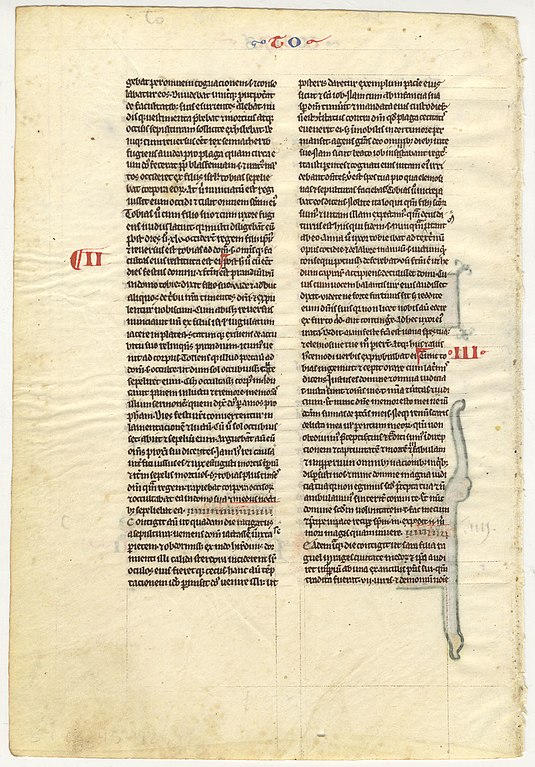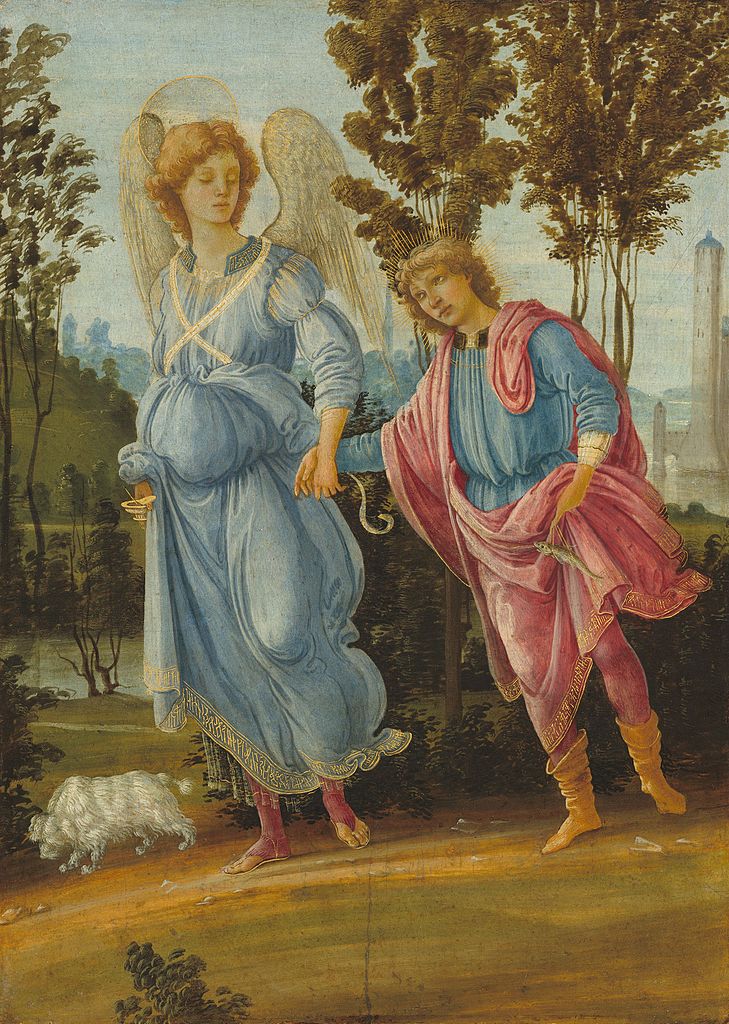Book of Tobit
The Book of Tobit, also known as the Book of Tobias or the Book of Tobi, is a 3rd or early 2nd century BC Jewish work describing how God tests the faithful, responds to prayers, and protects the covenant community (i.e., the Israelites).
The book is included in the Catholic and Orthodox canons but not in the Jewish; the Protestant tradition places it in the Apocrypha, with Anabaptists, Lutherans, Anglicans and Methodists recognising it as useful for purposes of edification and liturgy, albeit non-canonical in status. The vast majority of scholars recognize it as a work of fiction with some historical references.
Summary
The prologue tells the reader that this is the story of Tobit of the tribe of Naphtali, deported from Tishbe in Galilee to Nineveh by the Assyrians. He has always kept the laws of Moses, and brought offerings to the Temple in Jerusalem before the catastrophe of the Assyrian conquest. The narrative highlights his marriage to Anna, and they have a son named Tobias.
Tobit, a pious man, buries dead Israelites, but one evening while he sleeps he is blinded by a bird which defecates in his eyes. He becomes dependent on his wife, but accuses her of stealing and prays for death. Meanwhile, his relative Sarah, living in far-off Ecbatana, also prays for death because the demon Asmodeus has killed her suitors on their wedding nights and she is accused of having caused their deaths.
God hears their prayers and Archangel Raphael is sent to help them. Tobias is sent to recover money from a relative, and Raphael, in human disguise, offers to accompany him. On the way they catch a fish in the Tigris, and Raphael tells Tobias that the burnt heart and liver can drive out demons and the gall can cure blindness. They arrive in Ecbatana and meet Sarah, and as Raphael has predicted the demon is driven out.
Tobias and Sarah are married, Tobias grows wealthy, and they return to Nineveh (Assyria) where Tobit and Anna await them. Tobit's blindness is cured, and Raphael departs after admonishing Tobit and Tobias to bless God and declare his deeds to the people (the Israelites), to pray and fast, and to give alms. Tobit praises God, who has punished his people with exile but will show them mercy and rebuild the Temple if they turn to him.
In the epilogue Tobit tells Tobias that Nineveh will be destroyed as an example of wickedness; likewise Israel will be rendered desolate and the Temple will be destroyed, but Israel and the Temple will be restored; therefore Tobias should leave Nineveh, and he and his children should live in righteousness.
Textual history
The story in the Book of Tobit is set in the 8th century BC, but the book itself was written between 225 and 175 BC. No scholarly consensus exists on the place of composition ("almost every region of the ancient world seems to be a candidate"); a Mesopotamian origin seems logical given that the story takes place in Assyria and Persia and it mentions the Persian demon "aeshma daeva," rendered "Asmodeus," but it contains significant errors in geographical detail (such as the distance from Ecbatana to Rhages and their topography), and arguments against and in favor of Judean or Egyptian composition also exist.
Tobit exists in two Greek versions, one (Sinaiticus) longer than the other (Vaticanus and Alexandrinus). Aramaic and Hebrew fragments of Tobit (four Aramaic, one Hebrew – it is not clear which was the original language) found among the Dead Sea Scrolls at Qumran tend to align more closely with the longer or Sinaiticus version, which has formed the basis of most English translations in recent times.
The Vulgate places Tobit, Judith and Esther after the historical books (after Nehemiah). Some manuscripts of the Greek version place them after the wisdom writings.
Canonical status
Those Jewish books found in the Septuagint but not in the standard Masoretic canon of the Jewish Bible are called the deuterocanon, meaning "second canon." Catholic and Orthodox Christianity include it in the Biblical canon. As Protestants follow the Masoretic canon, they therefore do not include Tobit in their standard canon, but do recognise it in the category of deuterocanonical books called the "apocrypha."
The Book of Tobit was listed as a canonical book by numerous councils, including:
- the Council of Rome (AD 382)
- the Council of Hippo (AD 393)
- the Council of Carthage (397) and (AD 419)
- the Council of Florence (1442)
- the Council of Trent (1546)
It is part of the canon of both the Catholic Church and Eastern Orthodox Churches. Catholics refer to it as "deuterocanonical."
Augustine (c. AD 397) and Pope Innocent I (AD 405) affirmed Tobit as part of the Old Testament Canon. Athanasius (AD 367) mentioned that certain other books, including the book of Tobit, while not being part of the Canon, "were appointed by the Fathers to be read."
Influence
Tobit's place in the Christian canon allowed it to influence theology, art and culture in Europe. It was often dealt with by the early Church fathers, and the motif of Tobias and the fish (the fish being a symbol of Jesus Christ) was extremely popular in both art and theology. Particularly noteworthy in this connection are the works of Rembrandt, who, despite belonging to the Dutch Reformed Church, was responsible for a series of paintings and drawings illustrating episodes from the book.
Scholarship on folkloristics (for instance, Stith Thompson, Dov Noy, Heda Jason and Gédeon Huet) recognizes the Book of Tobit as containing an early incarnation of the story of The Grateful Dead, albeit with an angel as the hero's helper, instead of the spirit of a dead man.

